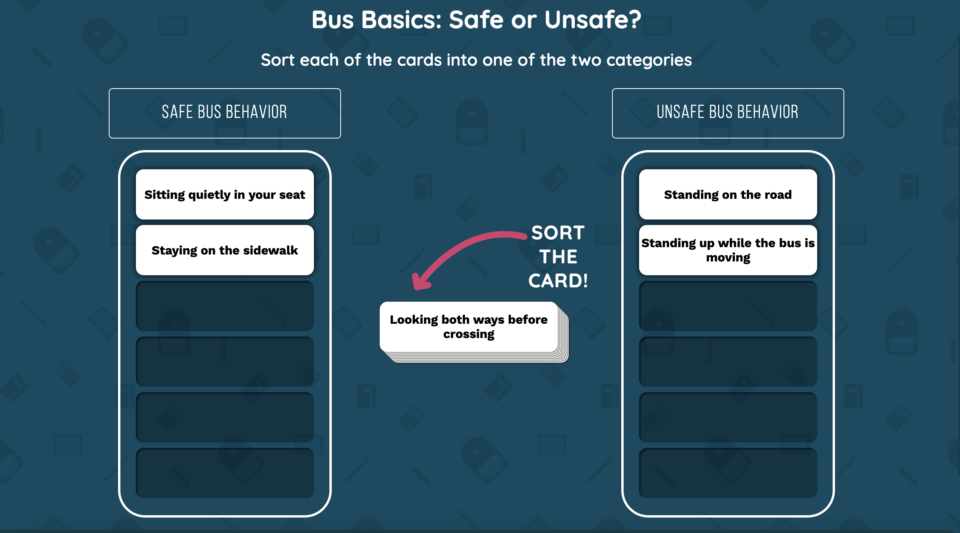
As elementary educators prepare for the new school year, teaching elementary students safe bus behavior is essential. With students often relying on buses as their primary mode of transportation to and from school, it’s crucial that they know how to keep themselves and others safe during their journey. But how can teachers make these safety lessons engaging and memorable?
Everyday Speech has created a digital interactive sorting activity designed to help elementary students learn and reinforce safe bus behavior. This back-to-school activity, “Safe or Unsafe Bus Behavior,” allows students to actively participate in categorizing various bus-related actions as either safe or unsafe. The best part? It’s an engaging, hands-on way to teach these essential safety skills.
Why Focus on Bus Safety at the Start of the School Year?
The start of a new school year is the perfect time to introduce or revisit important safety topics. For many students, especially those new to riding the bus, understanding what constitutes safe behavior is critical. Even for seasoned bus riders, a refresher on bus safety can help reinforce good habits and ensure that everyone starts the year on the right foot.
The Interactive Sorting Activity: How It Works
The “Safe or Unsafe Bus Behavior” activity is a simple yet effective tool that allows students to sort various actions into categories of safe and unsafe behavior. Here’s a breakdown of how the activity works:

1. Introduction to Bus Safety
Begin by discussing the importance of bus safety with your students. Explain that following safe bus practices is important not only for their own well-being but also for the safety of their peers. Introduce the activity as a fun way to learn and remember these rules.
2. Interactive Sorting
The digital activity presents students with various scenarios related to bus behavior. Each scenario is displayed on a card that students can drag and drop into one of two categories: “Safe Bus Behavior” or “Unsafe Bus Behavior.”
For example:
- Safe Bus Behavior: Sitting quietly in your seat, staying on the sidewalk, looking both ways before crossing.
- Unsafe Bus Behavior: Standing on the road, standing up while the bus is moving.
This interactive approach not only makes the learning process more engaging but also allows students to think critically about their actions and the consequences.
3. Class Discussion
After the sorting activity, take time to discuss the results with your students. Ask them why they placed certain actions in the safe or unsafe categories. This discussion helps reinforce the reasons behind each rule and encourages students to internalize the importance of bus safety.
Benefits of Using Digital Interactive Activities in the Classroom
Incorporating digital activities like the “Safe or Unsafe Bus Behavior” sorting exercise into your classroom offers several benefits:
- Engagement: Digital activities capture students’ attention and make learning fun. The interactive nature of this activity encourages active participation and helps students stay focused on the task at hand.
- Immediate Feedback: As students sort the cards, they receive immediate feedback on their choices. This helps correct misunderstandings in real-time and reinforces correct behavior.
- Ease of Use: The digital format is easy to use and can be accessed on various devices, making it convenient for both in-person and remote learning environments.
- Skill Reinforcement: The activity reinforces key bus safety skills that are critical for students’ daily routines, helping to ensure that these behaviors become second nature.
Unlock all of our Riding the Bus materials by signing up for your free trial today – no credit card required!
Access the full Social Communication Curriculum HERE!
Instant access to thousands of no-prep social skills activities, over 1000+ video lessons, and engaging games designed to enhance learning and development.
Conclusion
As you prepare for the upcoming school year, incorporating activities like the “Safe or Unsafe Bus Behavior” sorting exercise can help ensure that your students start the year with a strong understanding of bus safety. By making safety education interactive and engaging, you not only capture your students’ attention but also help them develop the habits and behaviors necessary to keep themselves and others safe.
The start of a new school year is an exciting time, full of new opportunities and experiences. By focusing on teaching elementary students safe bus behavior, you set the tone for a successful and secure school year. Explore Everyday Speech’s digital resources, including this bus safety activity, to enhance your back-to-school curriculum and create a safe and supportive learning environment for all your students.
Sample Video
Students learn best by watching others their same-age model the behavior! Check out a sample video modeling lesson below. We offer our entire Social-Emotional Learning platform free for 14 days here!
Related Blog Posts:
Free Elementary Problem-Solving Worksheet
Teaching Middle School Students to Stay Calm and Solve Problems
Teaching Problem-Solving Skills with Solve It: An Engaging Game for Elementary Students










